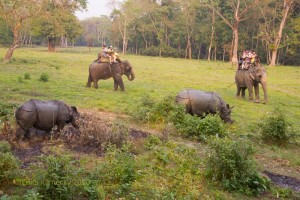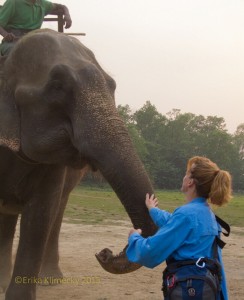I love the questions because I get lots insight into what people find interesting (they’re breaking ground so the rest of you don’t have to listen to the boring parts). But it also shows me the things that I take for granted about a month of travel in a foreign country. “How far is it?” one listener asked (remember, most things in Nepal are measured in time, not miles or kilometers). We spent 8 hours in a jeep on a gravel, half-paved road getting from Kathmandu to Chitwan (it’s 110 miles). At the time, we took a deep breath, yes, but it wasn’t daunting. It’s just the way you travel in Nepal, unless you have access to a helicopter, or want to spend almost the equivalent amount of time in tiny, hot airports.
Eight hours in my life at home is enough time to manage my business, volunteer in one of my kids’ schools, drop off, pick up said kids, grocery shop, get kids to their afternoon sports obligations and make dinner. It’s a lot of time at home that would be lost, or would trip up the system if it was interrupted. Eight hours on the road in Nepal is completely different. It’s time to learn new songs, see amazing landscape, (dodge cows and water buffalo) and watch communities go about their lives from the windows. It’s time to talk to people in your language and in theirs, to feel the hot, moist air and just enjoy being still while all else around you is moving. Eight hours in a car here at home is enough to get us from Seattle to Glacier National Park, or from Detroit to DC (Both are about 500 miles).

The purpose of my “stunning graphic” is to show you the elevation change from the north border to the south border of this amazing country. Keep in mind it’s about the same size and shape as Tennessee. It’s an average of 100 km (60 miles) from the south border to the north border, but the elevation difference is a lot harder to conceive.
The north border runs along the spine (the high ridge) of the Himalayas. Eight of the nine tallest mountains in the world are here. Only K2 is missing (it’s in Pakastan). Ninety peaks over 7000 meters (23,000 feet) run along that borderline. That’s taller than any mountains on any of the other continents (next highest is Aconcagua in Argentina at 22,841 or 6962 meters). It’s a thing that most people can’t imagine. You have to see it (you should). The south border feels like another part of the world, but it’s only 60 miles away. It runs along India’s north border, in the Terai region which is also described as the Gangetic Plain. The Ganges created its own flat, lowland which hosts rich farmland. Nepal’s south edge is in this hot, dry, dusty tropics, near sea level.
So here’s a little activity: Pick a spot on the south border (red lines are border) then pick the closest north border you can find. In those 65 miles, the land goes from zero to about 18,000 feet. That’s crazy! It’s the reason Nepal has the second highest hydropower potential in the world (Brazil is first, with the Amazon and their giant size). But with all of Nepal’s elevation change, it’s pretty difficult to build roads, homes, farmland or anything that remains accessible through the monsoon season (June to August).
It’s all just amazing stuff to ponder while you are driving 110 miles over 8 hours.
Other points of interest in the map:
Yellow on the right is our very approximate trekking route. It was about 70 miles of walking total.
Blue in the upper right is Mt Everest
Blue in the south is Chitwan National Park
Blue in the west is the city of Pokhara which is ‘on the way’ to Chitwan from Kathmandu (No, really, it is, ahem.)
Kathmandu is the underline in the center
You are seeing about two thirds of Nepal. Most of the west and some of the southeast is missing.
Kathmandu’s weather is subtropical. They grow bananas and papayas, grapes and tomatoes. Chitwan is fully tropical – sugar cane, coconut palms. It was 90 and sticky every day (in March), cooling to 60 at night. With the mosquitoes, it reminded me of a Minnesota summer, except the elephants and rhinos threw it off.
The Sagamartha (Everest) area is completely different simply because of the elevation. The beginning of our trek was about 7500 feet and we finished just shy of 14,000 feet. There was leftover snow still piled in the shadows at the top. That’s considerable since they are just finishing the dry season. It was 20 at night the coolest night and almost 50 during the day. (You don’t get to pet elephants there.)



